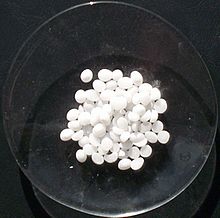
Back Kaliumhidroksied Afrikaans هيدروكسيد البوتاسيوم Arabic Hidróxidu de potasiu AST پوتاسیوم هیدروکسید AZB Калиев хидроксид Bulgarian পটাশিয়াম হাইড্রোক্সাইড Bengali/Bangla Kalij-hidroksid BS Hidròxid de potassi Catalan Hydroxid draselný Czech Калийлĕ сĕлтĕк CV
 | |
 | |
| Names | |
|---|---|
| IUPAC name
Potassium hydroxide
| |
Other names
| |
| Identifiers | |
3D model (JSmol)
|
|
| ChEBI | |
| ChemSpider | |
| ECHA InfoCard | 100.013.802 |
| EC Number |
|
| E number | E525 (acidity regulators, ...) |
PubChem CID
|
|
| RTECS number |
|
| UNII | |
| UN number | 1813 |
CompTox Dashboard (EPA)
|
|
| |
| |
| Properties | |
| KOH | |
| Molar mass | 56.105 g·mol−1 |
| Appearance | white solid, deliquescent |
| Odor | odorless |
| Density | 2.044 g/cm3 (20 °C)[1] 2.12 g/cm3 (25 °C)[2] |
| Melting point | 410[3][4] °C (770 °F; 683 K) |
| Boiling point | 1,327 °C (2,421 °F; 1,600 K) |
| 85 g/100 mL (-23.2 °C) 97 g/100 mL (0 °C) 121 g/100 mL (25 °C) 138.3 g/100 mL (50 °C) 162.9 g/100 mL (100 °C)[1][5] | |
| Solubility | soluble in alcohol, glycerol insoluble in ether, liquid ammonia |
| Solubility in methanol | 55 g/100 g (28 °C)[2] |
| Solubility in isopropanol | ~14 g / 100 g (28 °C) |
| Acidity (pKa) | 14.7[6] |
| −22.0·10−6 cm3/mol | |
Refractive index (nD)
|
1.409 (20 °C) |
| Thermochemistry | |
Heat capacity (C)
|
65.87 J/mol·K[2] |
Std molar
entropy (S⦵298) |
79.32 J/mol·K[2][7] |
Std enthalpy of
formation (ΔfH⦵298) |
-425.8 kJ/mol[2][7] |
Gibbs free energy (ΔfG⦵)
|
-380.2 kJ/mol[2] |
| Hazards | |
| GHS labelling: | |
  [8] [8]
| |
| Danger | |
| H290, H302, H314[8] | |
| P280, P305+P351+P338, P310[8] | |
| NFPA 704 (fire diamond) | |
| Flash point | nonflammable |
| Lethal dose or concentration (LD, LC): | |
LD50 (median dose)
|
273 mg/kg (oral, rat)[10] |
| NIOSH (US health exposure limits): | |
PEL (Permissible)
|
none[9] |
REL (Recommended)
|
C 2 mg/m3[9] |
IDLH (Immediate danger)
|
N.D.[9] |
| Safety data sheet (SDS) | ICSC 0357 |
| Related compounds | |
Other anions
|
Potassium hydrosulfide Potassium amide |
Other cations
|
Lithium hydroxide Sodium hydroxide Rubidium hydroxide Caesium hydroxide |
Related compounds
|
Potassium oxide |
Except where otherwise noted, data are given for materials in their standard state (at 25 °C [77 °F], 100 kPa).
| |
Potassium hydroxide is an inorganic compound with the formula KOH, and is commonly called caustic potash.
Along with sodium hydroxide (NaOH), KOH is a prototypical strong base. It has many industrial and niche applications, most of which utilize its caustic nature and its reactivity toward acids. An estimated 700,000 to 800,000 tonnes were produced in 2005. KOH is noteworthy as the precursor to most soft and liquid soaps, as well as numerous potassium-containing chemicals. It is a white solid that is dangerously corrosive.[11]
- ^ a b Lide, D. R., ed. (2005). CRC Handbook of Chemistry and Physics (86th ed.). Boca Raton, Florida: CRC Press. p. 4-80. ISBN 0-8493-0486-5.
- ^ a b c d e f "potassium hydroxide". chemister.ru. Archived from the original on 18 May 2014. Retrieved 8 May 2018.
- ^ Otto, H.W; Seward, R.P. (1964). "Phase equilibria in the potassium hydroxide-sodium hydroxide system". J. Chem. Eng. Data. 9 (4): 507–508. doi:10.1021/je60023a009.
- ^ Seward, R.P; Martin, K.E. (1949). "The melting point of potassium hydroxide". J. Am. Chem. Soc. 71 (10): 3564–3565. doi:10.1021/ja01178a530.
- ^ Seidell, Atherton; Linke, William F. (1952). Solubilities of Inorganic and Organic Compounds. Van Nostrand. Retrieved 2014-05-29.
- ^ Popov, K.; et al. (2002). "7Li, 23Na, 39K and 133Cs NMR comparative equilibrium study of alkali metal cation hydroxide complexes in aqueous solutions. First numerical value for CsOH formation". Inorganic Chemistry Communications. 3 (5): 223–225. doi:10.1016/S1387-7003(02)00335-0. ISSN 1387-7003. Retrieved October 20, 2018.
- ^ a b Zumdahl, Steven S. (2009). Chemical Principles 6th Ed. Houghton Mifflin Company. p. A22. ISBN 978-0-618-94690-7.
- ^ a b c Sigma-Aldrich Co., Potassium hydroxide. Retrieved on 2014-05-18.
- ^ a b c NIOSH Pocket Guide to Chemical Hazards. "#0523". National Institute for Occupational Safety and Health (NIOSH).
- ^ Chambers, Michael. "ChemIDplus - 1310-58-3 - KWYUFKZDYYNOTN-UHFFFAOYSA-M - Potassium hydroxide [JAN:NF] - Similar structures search, synonyms, formulas, resource links, and other chemical information". chem.sis.nlm.nih.gov. Archived from the original on 12 August 2014. Retrieved 8 May 2018.
- ^ Schultz, Heinz; Bauer, Günter; Schachl, Erich; Hagedorn, Fritz; Schmittinger, Peter (2005). "Potassium Compounds". Ullmann's Encyclopedia of Industrial Chemistry. Weinheim, Germany: Wiley-VCH. doi:10.1002/14356007.a22_039. ISBN 978-3-527-30673-2.
